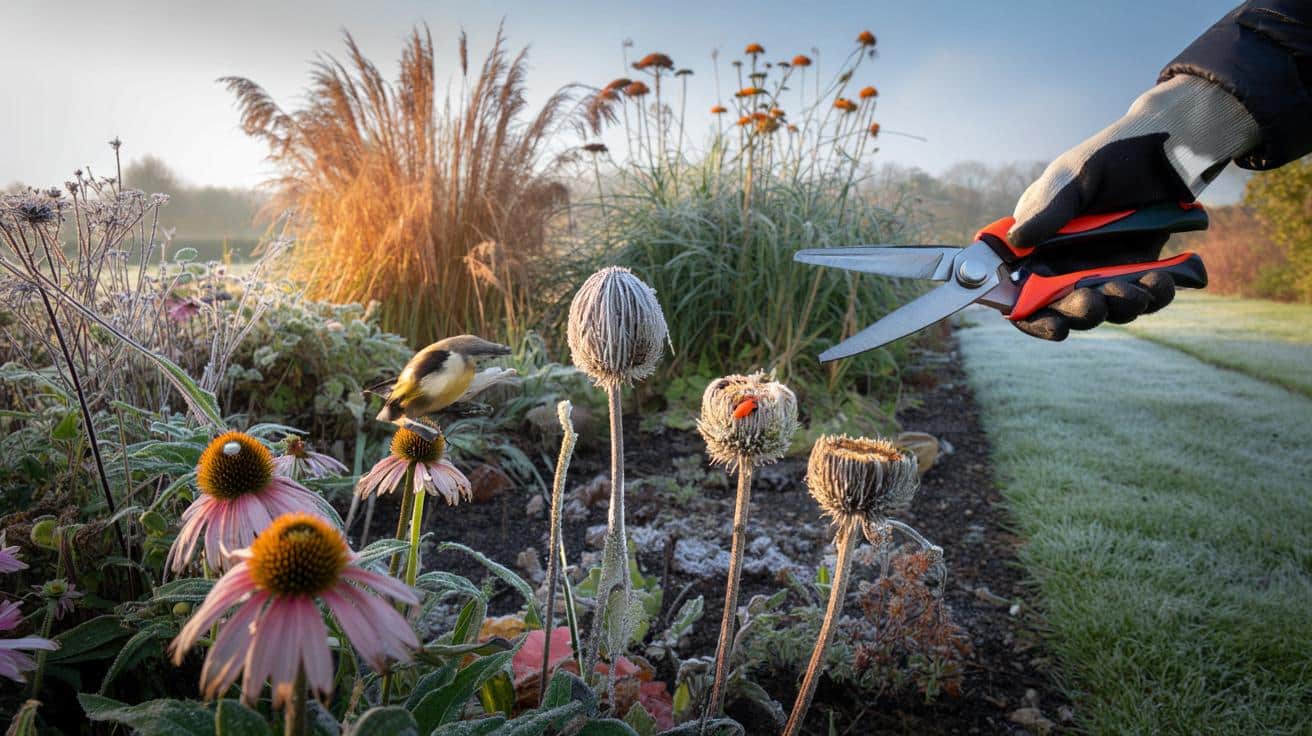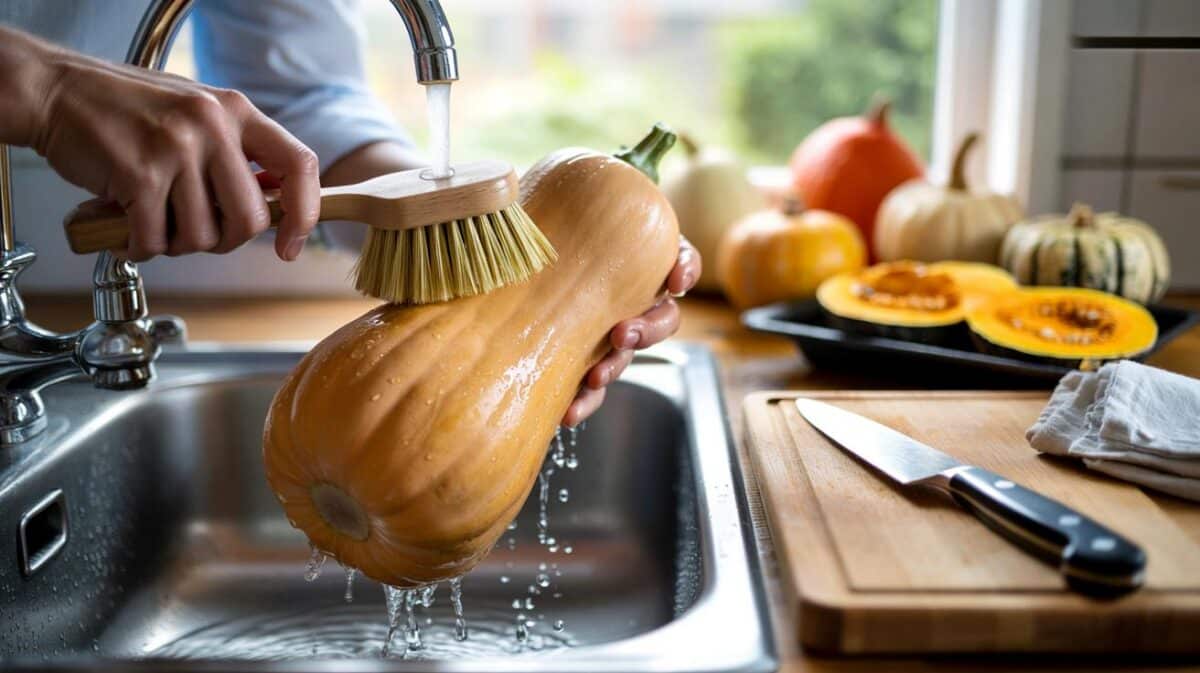Across the country, landscapers are urging people to resist the tidy-up reflex and leave those brown seedheads standing. The case goes beyond sentiment. Wildlife needs shelter, soil needs cover, and your spring display may well repay your patience.
Why leaving faded beds now can rescue your winter garden
A refuge for small wildlife when frosts bite
Dry stems and seedheads form a ready-made hostel for ladybirds, lacewings, bees and moths. Hollow stems house beneficial insects. Finches and sparrows feed from rudbeckia, echinacea and teasel through lean months. In many towns, where hedges and rough corners are scarce, a messy border can be the only winter shelter.
Leave hollow stems and seedheads standing to give insects a dry, frost-free refuge and birds a reliable snack bar.
A natural blanket that protects soil and structure
Bare soil loses warmth and nutrients in driving rain. It compacts under foot traffic and repeated downpours. A mat of fallen leaves and toppled stems slows water, reduces erosion on slopes, and keeps the surface crumbly. As the material breaks down, fungi and microbes recycle it into fertility that roots can use in spring.
Texture, shadow and a different kind of beauty
Frost outlines umbellifers in silver. Miscanthus plumes glow in low sun. Even the ordinary seedheads of cosmos catch dew and sparkle. Instead of a flat, raked bed, you get drama and silhouettes that change by the hour. Many designers now plan for this “second season”, choosing plants that stand tall and look good in decay.
What you gain by doing less this season
Time saved, costs avoided, backs spared
Hauling sacks of wet stems to the tip takes hours. Skip fees and extra bin charges add up. Leave most growth in place and you shift the heavy lift to a short, dry spell at the end of winter, when stems are crisp and easy to snip.
| Border size | Autumn clear-out | Leave standing | Likely saving |
|---|---|---|---|
| 20 m² mixed bed | 3 bags green waste, 4–5 hours work | 1 bag selective removals, 1–2 hours | 2–3 hours and ~£10–£18 disposal/fuel |
| 50 m² mixed bed | 6–8 bags, 8–10 hours | 2–3 bags, 3–4 hours | 5–6 hours and ~£30–£48 |
Swap a frantic November clear-out for a two-hour March edit and keep your energy for pruning and planting.
A self-sown spring you didn’t have to pay for
Many annuals and short-lived perennials drop seed in late autumn. If you avoid ripping them out, you often gain a soft wave of new plants for free. Nigella, calendula, poppies and cosmos drift into gaps. You can always thin them in April to keep a planned look.
A soil food cycle that strengthens borders
As stems collapse, they feed the fungal “wood wide web” that binds particles and trades nutrients with roots. You need fewer bags of compost and less feed when the bed makes its own mulch. Earthworms pull fragments down, leaving a friable tilth right where new growth will push through.
What to keep, what to clear, and how to make it look intentional
Keep these for structure and wildlife
- Grasses such as miscanthus, calamagrostis and stipa for movement, cover and winter glow.
- Perennials with sturdy stems: echinacea, rudbeckia, asters, verbena bonariensis, sedum (hylotelephium).
- Self-seeders that play nicely: cosmos, calendula, nigella, foxglove, honesty.
- Umbellifers like fennel and cow parsley for frosted silhouettes.
Clear these before they spread trouble
- Anything with visible mildew, rust or canker; bin it rather than compost it.
- Plants harbouring slugs or vine weevil grubs in pots; refresh compost and inspect roots.
- Invasives that root at the nodes or set prolific seed you cannot manage next year.
Design tricks so “messy” looks managed
Edge beds with a clean spade line or a low box of evergreen herbs to frame the looser centre. Cut a few sightlines through the planting so you can read the structure. Gather handfuls of stems into small stooks with soft twine and set them like mini-sculptures at the back of a border. Keep paths swept and the lawn edged; tidy edges make wild middles look deliberate.
Crisp edges plus curated chaos is the formula: frame the border and let the middle breathe.
When to act again, and how to do it without harm
Timing the spring cut-back
In most of the UK, late February to mid-March suits a first cut. Choose a dry day so stems are brittle. Snip to 5–10 cm above the crown, working in small sections to avoid treading soft growth. Check for sleeping wildlife before you start; move bundles gently to a quiet corner for a fortnight so late risers can crawl out.
What to do with the debris
Chop stems by hand secateurs or a hedge trimmer into 5–10 cm pieces and spread them as a light mulch between clumps. Add only diseased material to council green waste. The rest feeds the bed. If you prefer a cleaner look, mulch with leafmould after cutting and tuck the chopped stems beneath it.
Your quick winter action plan
- Walk the borders monthly and remove anything diseased or dangerously loose.
- Top up bird food by shaking a few dry seedheads into a tray near a window.
- Pinch out self-seeders where you do not want them; leave a few to fill gaps.
- Lay a single pass of light mulch on waterlogged patches; avoid digging wet soil.
- Prop tall grasses with discreet canes if wind snaps them near the crown.
Extra context: how this fits with low-dig and wildlife gardening
This hands-off approach pairs neatly with no-dig methods. You disturb the soil less, so fungal networks stay intact and weeds germinate less readily. It also scales to small spaces. On a balcony, leave seedheads on hardy herbs and grasses, wrap pots against frost, and cut back in March.
There are limits. Slugs can shelter under dense mats; use spacing and birds to keep them in check. Some self-seeders get exuberant; deadhead part of a plant to cap the seed bank while leaving enough for wildlife. If you maintain an immaculate front verge for neighbours, adopt a 70/30 split: trim the front third, keep the back two-thirds wild through winter.
Do less now, get more later: shelter for wildlife, richer soil, free seedlings and a spring border that wakes faster.








